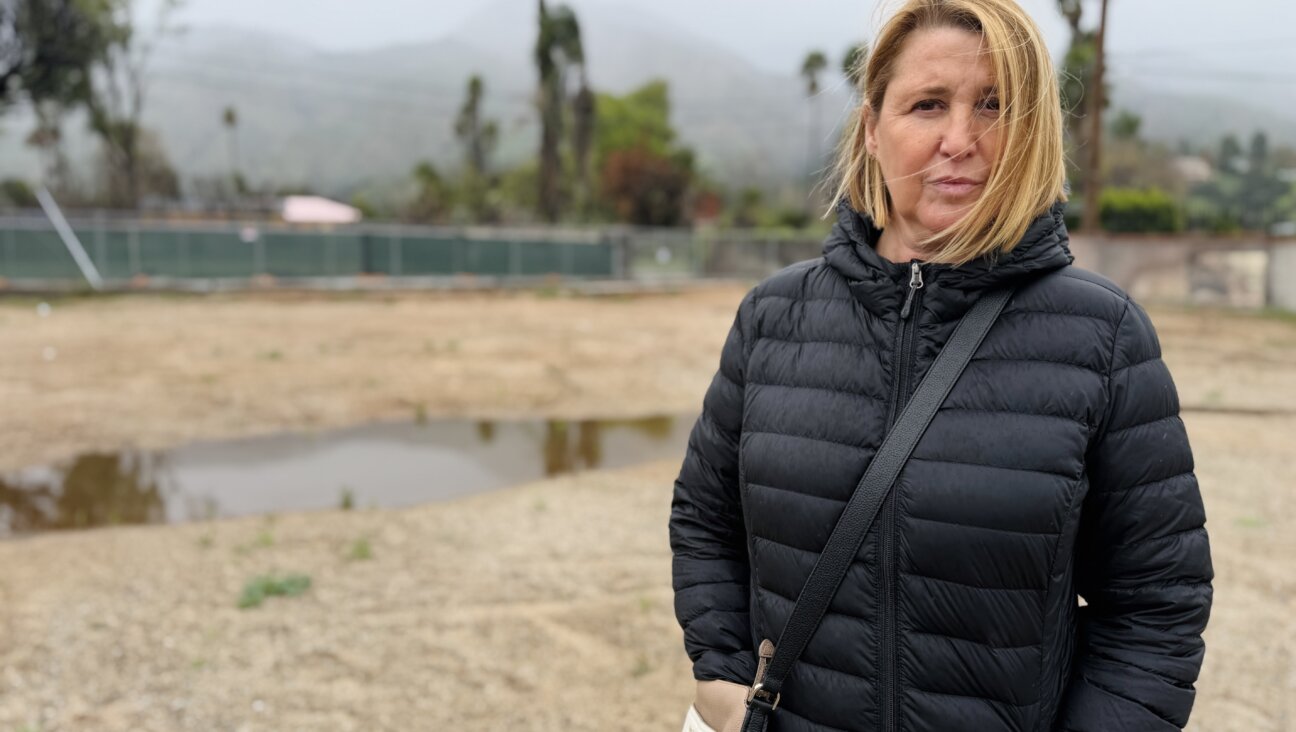In Wake Of California Fires, Jewish Mourning Customs Can Teach Us How To Console

Image by Getty Images/Forward montage
The image of the menorah on the top of a Malibu hill, surrounded by the smoldering landscape of the Wilshire Boulevard Temple Camps, is perhaps one of the most harrowing to come out of the fires ravaging California. For me, a California-based rabbi, it is at once a symbol of both destruction and survival.

Camp Hess Kramer Image by facebook
With dozens of people killed, hundreds missing, and over 150,000 displaced, California has been plunged into a state of mourning. In the Bay Area, people walk around wearing face-masks; a dark pall has fallen over us, and we stare at each other in shock that we are among the first American victims of climate change.
In this trying time, ancient Jewish traditions of bereavement, and comforting mourners, may offer a poignant framework for how the American Jewish community can support their brethren on the West Coast.
The Malibu menorah is a powerful icon for the challenges that our community currently faces, largely because it evokes ancestral memories of Jerusalem’s Temple — a victim of fire. It is a reminder of the many cycles of tragedy and resilience throughout Jewish history, a place tied to all Abrahamic religions, and directs us to revisit an important value in which our traditions are rooted: Healing.
Throughout the Talmud’s accounts of the Temple’s origins, healing was evidently a primary intention at the foundation of Western Religion. According to Semachot, a minor tractate of the Talmud addressing death and mourning, King Solomon dedicated the First Temple with the pronouncement, quoted above, that the Temple should be a place for comfort and healing. This is echoed further in Psalm 30, where a certain healing ritual dance called ” machol ” and often performed by women in the form of a circle, was done in the Temple.
In Semachot’s description of how vulnerable people entered the Temple, we see this healing circle dance in action. It offers a template for caregiving that has evolved over time as destruction, exile, and persecution called for other healing rituals:
Who are they who circle to the left? A mourner, an ex-communicant, one who has someone sick at home, and one concerned about a lost object…[to the Mourner,] they would say… “May he who dwells in this place comfort you.” (Semachot: 6: 12: The Tractate “Mourning”)
According to this passage, mourners who came to the Temple would enter through a separate gate, leading them to a designated Mourners’ Path. As they walked this path through the courtyard on the Temple Mount, they came face-to-face (which in Hebrew also means “soul-to-soul”) with other members of the community who greeted them with the formulaic and non-intrusive blessing, “HaMakom Y’nechem”, or, “May The-One-Who-Dwells-In-This-Place comfort you.”
“HaMakom,” God’s name in this Mourners’ Blessing, literally means “The Place.” This contrasts with most Hebrew names for God, which come with descriptive characteristics. HaMakom/The Place, in contrast, does not describe. HaMakom embraces the mourner without defining the embrace, intruding upon the mourner’s experience, or prescribing their behavior. This validates the range of feelings attendant to each unique experience of grief.
Notable in the Semachot passage is the variety of vulnerable people sharing the Mourner’s Path; the text acknowledges the common experiences of loss, by including financial reverses, illness, relocation, and social status change under the category of “mourner.” The ancient sages thus guide us to draw upon the time-line of Jewish mourning practices, which evolved following the Temple’s loss, as we reach out to the victims in the aftermath of the fires that plague California, many of whom have lost all of their belongings.
The holy, protective cocoon implicit in HaMakom Y’nechem remains, forbidding us from offering comfort when trauma is still fresh. We are instructed to refrain from comforting a mourner when the dead remains unburied. We are to visit the House of Shiva in silence and wait for the mourner to begin a conversation, while addressing their physical needs by bringing them food.
These instructions, resonant with Abraham Maslow’s pyramid of needs, place physical care and safety as the foundation for care. Only after the physiological and safety needs of someone in stress have been met, can we begin to address their emotional and spiritual needs.
As the embers continue to smolder, we don’t ask survivors how they are. We don’t rush to help the mourners find meaning, while their experiences are still so raw. We approach them with the spacious protection provided to those who walked the Temple’s Mourners’ Path: We do not judge them as their numbness thaws and their emotions spill over, remembering the Talmudic teaching that, “One is not held liable for what is said when suffering.” (Talmud: Bava Batra 16B)
Instead, community members must merely remain present, like those who say “Amen” to the Kaddishes recited by mourners, for the duration of their time of mourning.
That gift of non-judgmental and continual presence creates a safe container in which mourners can begin to find their voice and regain energy to rebuild their lives. As we Californians turn to the rubble and start to piece our lives back together, Jewish practices can teach us mourners how to regain equilibrium, and return to thriving, while also instructing the larger American community about how to best support us, as the smoke clears.
Our practices provide a path to resilience forged through millennia of Jewish suffering, and can serve as a beacon of hope on the journey to healing, like the menorah that stands in Malibu — surveying destruction, while lighting the way.
Rabbi Anne Brener, LCSW, is Professor of Ritual and Spiritual Development at the Academy for Jewish Religion, California. She is a psychotherapist and a spiritual director and is the author of the 25th Anniversary Third Edition of ‘Mourning & Mitzvah’ (Turner/Jewish Lights).
















